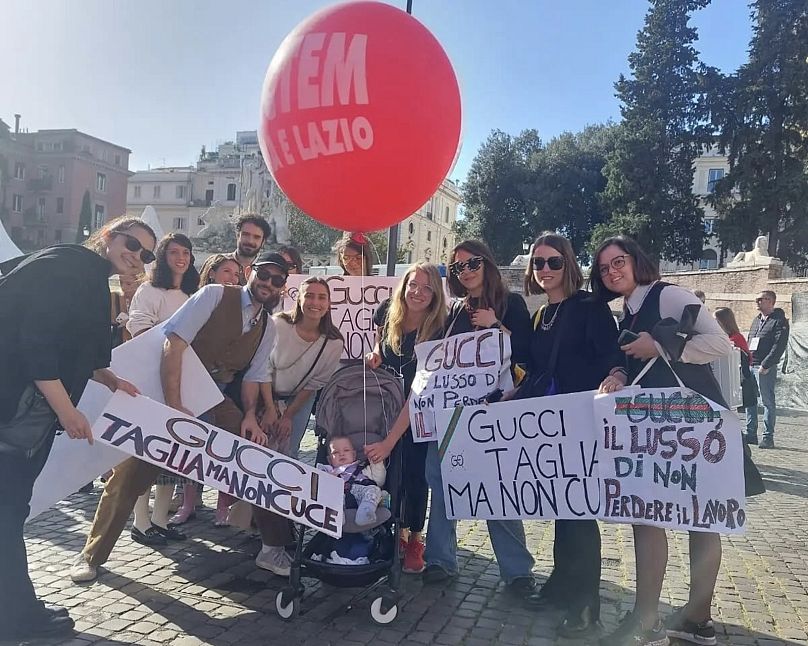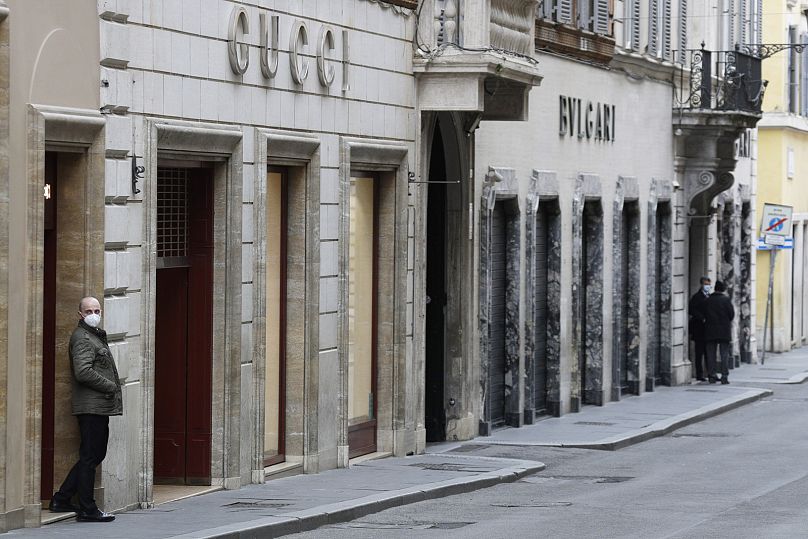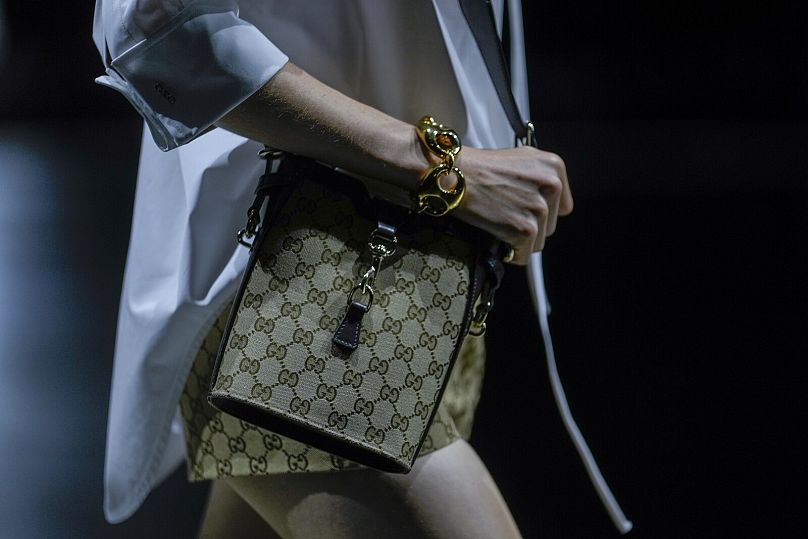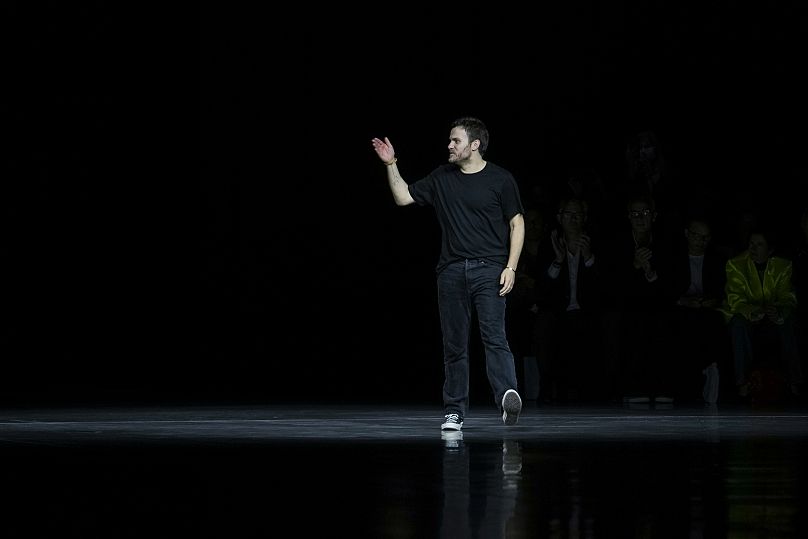Gucci employees are striking in Rome over what they claim is "collective dismissal" by the company. But a lot more could be at stake for the Italian luxury brand, including its upcoming fashion show.
Italian fashion powerhouse Gucci has become widely synonymous with luxury and glamour, but it has also been unable to escape controversy.
In its 102 years of history, the brand's name — taken directly from its founder, Guccio Gucci — has been dragged through a myriad of widely publicised scandals, ranging from accusations of racially insensitive designs and tax evasion to the murder of its former head by his ex-wife — the source of recent silver screen treatment.
Now, the Florence-based titan is finding itself in hot water with staff striking in protest against a recent decision they deem tantamount to a collective dismissal.
So what is the cause of the ongoing "stitchuation", and possible repercussions for the brand? Euronews Culture investigates.
Why and where are workers striking?
Gucci, which is currently owned by French multinational Kering after its founder's family relinquished control in the 1990s, employs 20,711 individuals around the world.
Despite its French ownership, it remains a firmly Italian-based company, with its headquarters in Florence, offices in Milan and Rome, and 95% of its manufacturers in the country.
It's in Italy's capital where a recent company decision to transfer 153 out of 219 employees to Milan has caused a significant upset, with employees taking to the streets to voice their discontent.
Euronews Culture spoke to Gucci employees who claim that the decision was officially communicated in October, with selected individuals being told to relocate come 1 March 2024.
The workers in questions allege that they were not given the proper conditions to adjust to such a move (including salaries adjusted to Milan's higher cost of living) and found themselves having to leave family and home without viable alternatives.
According to one trade union rep, that asked to remain anonymous, this amounts to a "collective dismissal in disguise".
"We have tried to speak to Gucci's HR, but have not received any response," they stated.
"It feels like being caught in a blender," one employee told Euronews Culture.
"We've been living in anxiety for months after seeing estate agents and prospective buyers come to the Rome offices, but our fears were confirmed after the summer holidays," they added. "We were forced to relocate with no alternatives being provided for us here in Rome. I have built my life here and have bought my house — this leaves me in a very difficult position."
Consequently, over a dozen workers protested in Rome's Piazza del Popolo on Friday 17 November, hoping to raise awareness of their situation.
"Gucci cuts but it doesn't sew", one protester's sign read.
"The luxury of not losing your job," read another.
A larger protest in Rome is planned for this Monday, to which members of the press have been invited.
The controversy has also made its way to Italy's parliamentary chambers, with two left-wing MPs — Nicola Fratoianni and Franco Mari — raising the issue in the country's lower house last Friday.
"Gucci announced [the decision]... without consulting trade unions," they stated. "This warrants an immediate intervention on behalf of the Ministers in question to understand what are the real intentions of Gucci and Kering."
"There are around 220 employees, but there are also 100 workers including receptionists, the security, maintenance and shipment teams, that are even less protected", they added.
It's not the first time that a Kering-owned company has been accused of collective dismissals. Last year, luxury menswear label, Brioni, saw Italian trade unions mobilise after 24 of its employees were fired.
What are the possible implications for the brand?
But what may seem like an internal labour dispute, nevertheless could, protesters allege, have an impact on the brand's image and upcoming designs, especially for its January collection.
"The protests will continue all of this month and the next too, and this will probably have a bearing on January's fashion show," Gucci's Rome trade union representative claimed.
According to the rep, what could truly cause the brand's January show to grind to a halt is if the production team in Tuscany is affected — and that is not off the table.
"[Gucci] is starting to make cuts to production as well, that is the industrial sector in Tuscany," they added, stating that the protests were spreading beyond Rome.
For another Gucci employee in Rome, the impact was less linked to possible issues with the production sector, but rather to the design team's emotional and psychological well-being.
"It's possible that some damage will be done to the January collection," they stated. "I'm surrounded by workers who are drained, who just can't handle it anymore."
Some other strikers are less optimistic regarding a tangible impact, claiming that too many employees, especially in Milan, are fearful that it could impact their jobs, especially as walkouts are relatively rare within the fashion world.
"Everyone is too scared", one Rome-based employee told Euronews Culture. "I've seen some appalling situations... colleagues I speak to say 'it's not possible to go out and strike, in our field of work.'"
"But it's time now for us to open our mouths."
Next January's fashion show is a particularly important moment for the Italian fashion house, as it represents the first winter/fall collection of Sabato De Sarno, Gucci's newly appointed creative director.
In response to the claims Gucci released this statement:
“Regarding the protests related to the transfer of the Design Office from Rome to Milan, Gucci confirms that this transfer was announced to trade unions in early October. It does not involve any staff reductions and will be carried out in full compliance with current regulations.
In this regard, the Company has introduced a set of measures, encompassing both economic incentives and active support, designed to facilitate the relocation of all employees involved. These measures are notably more favorable than those stipulated in the Italian national collective agreement.
With the move to Milan, the Creative Director and the different teams involved will have the opportunity to collaborate closely with the strategic functions of the company already based in the city, thus maximizing the necessary interactions and synergies.”















